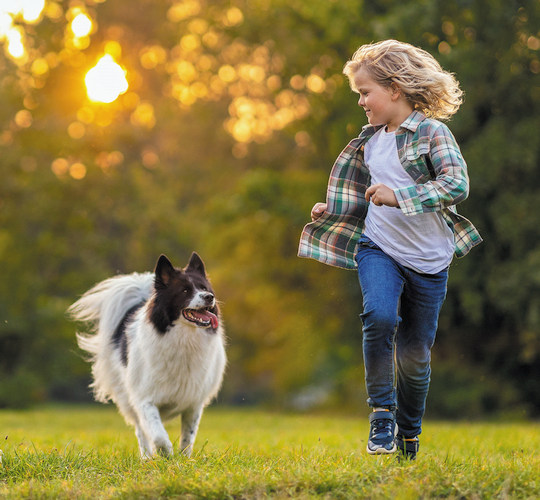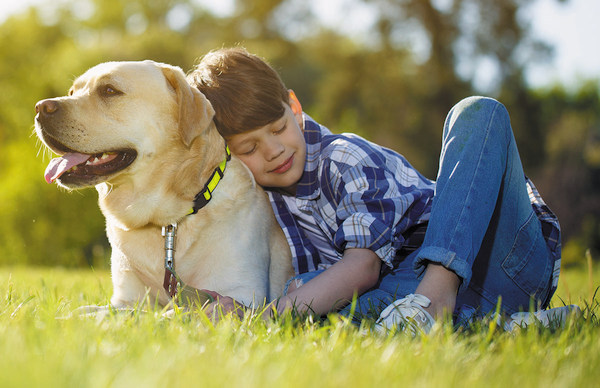By Heidi Dahms Foster

The endearing relationships possible between children and dogs are heartwarming. But the results when those relationships fall apart can be horrifying, often ending in serious injury or even death. The sad truth is that these horror stories are preventable if kids are taught to properly interact with dogs, and dogs are supervised around children. Putting a few rules into place from early childhood will protect your child and your pets.
Always Supervise
Dogs are living creatures, and no matter how gentle and well trained, can be unpredictable. Supervision is paramount – never leave your young children alone with dogs. It’s always better to err on the side of caution.
Teach Respect from an Early Age
Very young children can learn to treat dogs with kindness, respect and care. Toddlers are active and loud, and may grab, slap, squeeze, or roughly hug, which can be overwhelming for dogs. They also may not understand appropriate behavior around a dog, and they’ll need your supervision at all times.
Young puppies, like young children, are fragile, and must be handled gently. Teach children to sit before picking them up, so they don’t accidently drop and injure a squirming pup. Never leave a toddler unattended around a young puppy. Older dogs need the same considerations as they slow down or suffer from age-related discomforts.
Important other items to teach your child include:
Approach and handle a dog properly. Teach your children to always ask permission before approaching a strange dog. They should allow the dog to approach them first. Most dogs don’t like someone to reach for the top of their head. Best is for your child to offer an open palm underneath the chin. If the dog backs off, then the child should also take a step back and allow the dog its space. A child should never approach an unattended dog or reach over a fence or through a car window to pet a dog.
Use caution around food and toys. Many dogs are understandably protective of their food and toys. Children should never bother a dog that is eating, and should be taught to observe body language when playing with toys. Games of fetch and tug of war are fun, but watch that your dog doesn’t get too “grabby” with toys and balls. Teach your dog to let go of toys and balls on command (“out”) and wait for you or your child to throw the ball or give back the toy.
How to properly offer a treat to a dog. Children should offer a treat to the dog with an open palm, and not play “keep away” with treats or toys. Train your dog to take treats gently.
Watch for Health Issues
Some sad stories have emerged in which a child has pulled a dog’s ears or otherwise handled them and is bitten. The family panics and requests the dog be put down, only to find that the animal had a severe, painful ear infection or other health issue that caused the behavior. Since children are not able to realize when a dog’s health is going to cause a problem, it is up to you to monitor your pet’s health.
Regular grooming and vet checks can bring health problems to light before they cause trouble. Don’t forget proper vaccinations, especially rabies. Be aware of sudden changes in behavior, as these can indicate health problems. As dogs age, they can suffer from health conditions that may cause them to be more intolerant around kids.
Understand Your Dog’s Body Language
Age appropriately, teach your child to understand your dog’s signals. Some things to watch for include yawning, a common sign of stress, and “whale eye,” in which a large amount of white shows in the eyes of a very uncomfortable or fearful dog. Pay attention to avoidance behaviors. If your dog is trying to get away from your child, teach the child to respect that space, or intervene and separate the two where needed.
Many bites have occurred because a child puts their face into a dog’s face, especially a strange dog. This can cause extreme reaction in some animals.
Model the Right Behaviors for Your Child

Your children are far more apt to do what you do regardless of what you tell them. If you show gentle training and handling, patience, and respect for your dog, your child will learn from observing. Show them that even if your dog misbehaves or becomes too excited, it’s never OK to treat them roughly. Interrupt less than desirable behaviors in your children and your dog, and redirect them.
Teach children how to avoid an overactive or nipping puppy, and be ready to intervene if necessary. Dogs of any shape, size or breed are capable of biting under the right circumstances. It’s your responsibility to protect both your child and your dog.
Let your child help with care, feeding and grooming, and how to appropriately throw a ball or play other games.
Training is the Foundation
Proper training from puppyhood is one of the best ways to avoid problems between children and dogs. Always ask a trainer if you need help, because there is no room for error when it comes to protecting your child. If you notice dog aggression toward children of any age, seek professional guidance. Positive training can help you deal with such problems as jumping and nipping, and teach basic manners. When you can, involve your children in these classes to help their understanding of dog behavior and proper treatment.
Be aware of your dog’s breed traits and monitor for problems. Herding dogs will herd, some incessantly, and must be redirected. Some dogs, especially larger ones, can jump and knock children over, or cause scratches and other injuries. Others are just so excitable that children don’t know how to deal with them.
Is a Break in Order?
All of us, humans and dogs, need a break from time to time. Provide a crate or quiet space with a baby gate or play pen. Perhaps some doggie day care a couple of days each week will give them an outlet and a fun way to expend some energy. A walk with just you and your dog, or some play time with the two of you, will work wonders.
Enjoy Fun Events Together
More and more dog sports are now available, not just to purebred dogs but also for mixed breeds. Check in your area for agility, obedience and rally obedience, scent work, and FastCat events and lessons. Many children and teens participate in these sports, building strong relationships with their dogs, and making new friends.
Some places to look for training and competition resources include:
Prescott Arizona Kennel Club (prescottarizonakennelclub.com)
Chino Valley Canine Training Club (cvctc.net)
Yavapai County 4-H (extension.arizona.edu/4h/yavapai)
Search online for “Prescott area dog training”

